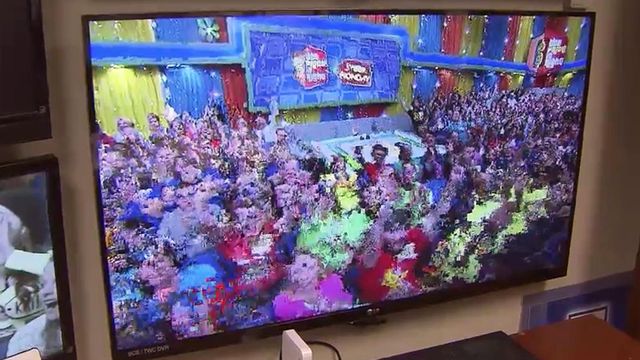Spectrum battle puts 4G, cable in conflict
Cable customers who see a jerky television picture may call the TV station or even their cable provider to report the problem. What they might not expect is that other electronics are creating the interference that results in a pixelated picture.
Posted — UpdatedTime Warner Cable in the Triangle recently placed some channels, including WRAL, on the same spot in the broadband spectrum that serves Verizon's 4G LTE data service. Those with phones on the Verizon network are most likely to see the interference.
In June, Verizon finished the rollout of 4G LTE in the 700 MHz band of spectrum. It is the only wireless carrier using that part of the spectrum. Time Warner uses that same spectrum for some channels in the Triangle, so when a 4G device and a cable box are in the same room, they can come into conflict.
"Every time my wife comes home from work and we watch TV, that's when the problem happens," said Jeff Lipack of Raleigh, noting that he doesn't have 4G LTE service but his wife does.
Cable boxes lack the kind of shielding to block interference from other devices, and the LTE phones create the interference inside the set-top boxes whenever the user checks email, sends a text or a tweet, posts a Facebook update or surfs the Internet. It can even happen when no one is using the phone, officials said, as the phone is often doing background communications over the LTE network.
Check out this video to see it in action:
"We apologize for the inconvenience and are working on a solution that will resolve this problem definitively in the coming weeks," Time Warner said in a statement.
Sam Matheny, vice president of policy and innovation at Capitol Broadcasting Co., WRAL's parent company, said Time Warner plans to shift the station and FOX 50 off the 700 MHz band.
"It's going to take time," Matheny added.
The issue will become more acute for the cable industry as the number of LTE devices grows. Already, more than one-third of Verizon's 101 million customers have such phones, and IPG Media Lab reports 60 percent of people use a smartphone or tablet while watching TV.
Time Warner officials said such "hyper-local interference" might be resolved simply by taking the phone to another room.
People also can put their phones on airplane mode. That solves the interference with TV, but they won't be able to use their phones until switching back.
Another solution involves turning off the 4G service and using Wi-Fi to access the Internet.
Lipack said a new cable box solved the problem at his home, but it hasn't worked for others.
"I still have some friends on Facebook who are complaining about the problem," he said.
• Credits
Copyright 2024 by Capitol Broadcasting Company. All rights reserved. This material may not be published, broadcast, rewritten or redistributed.






